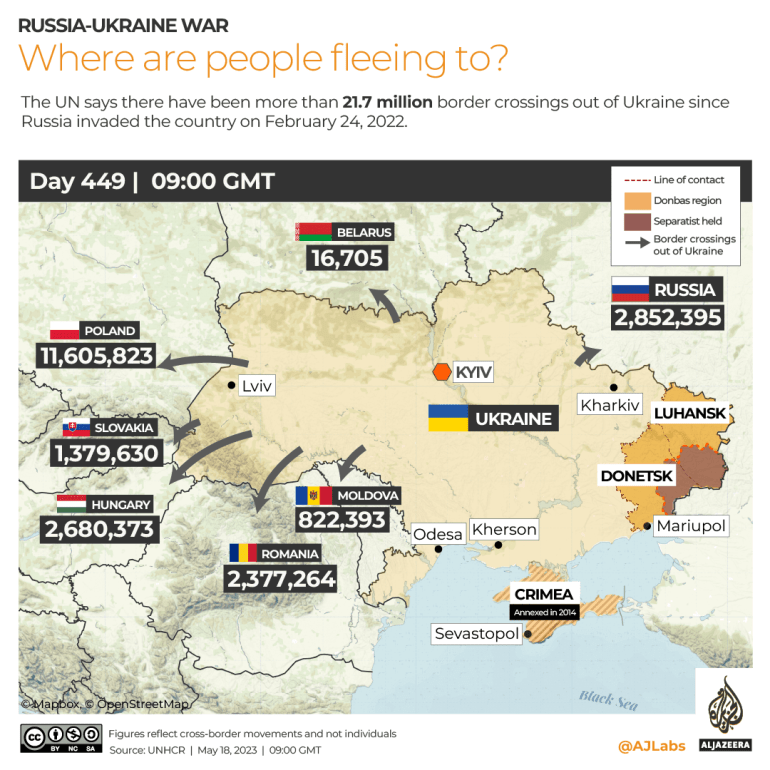Ukraine battles Russia in Bakhmut as Zelenskyy secures more arms
What happened in the 64th week of Russia’s war in Ukraine?
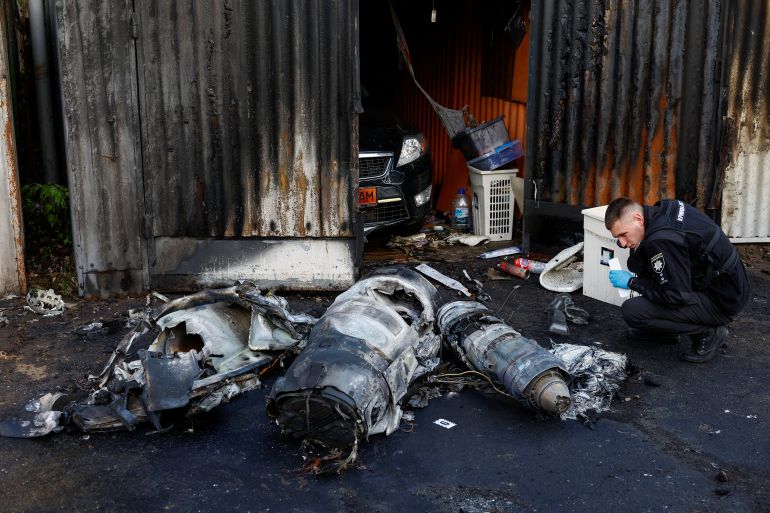
Ukrainian forces pushed back Russian occupiers north and south of Bakhmut in the 64th week of the war, successfully pressing a counterattack they had begun on May 9.
As Russian troops fell back on the flanks of the city, Wagner Group mercenaries continued to push through the eastern city itself, claiming much of the last Ukrainian foothold in its western suburbs.
Keep reading
list of 4 itemsUkraine repels ‘exceptional’ Russia missile, drone attack on Kyiv
‘The longest and loudest shelling in Kyiv since the war began’
Russian cruise missile attack targets Kyiv, one killed in Odesa
“Our troops liberated about 20 square kilometres [7.7sq miles] from the enemy in the north and south of the suburbs of Bakhmut. At the same time, the enemy is making some progress in Bakhmut itself, completely destroying the city with artillery,” said Ukrainian deputy defence minister Hanna Maliar, on May 14.
Russia’s defence ministry said Ukraine had launched an assault north of Bakhmut, with more than 1,000 troops and up to 40 tanks. If confirmed, that “would amount to the biggest Ukrainian offensive since November”, said the Washington-based Institute for the Study of War.
The Ukrainian commander of ground forces, Oleksandr Syrskyi, confirmed a new phase had begun, calling it “the first success of offensive operations during the operation for the defence of Bakhmut.”
“However, this is only a partial success. And that is how it should be perceived,” he wrote.
Blow-by-blow
Eastern forces spokesman Serhii Cherevaty said Ukrainian troops had on May 11 advanced “into the depth of enemy positions from 250 metres [820 feet] to one and a half kilometres [0.93 miles].”
Maliar put the advance at two kilometres (1.24 miles).
Geolocated footage posted on May 12 showed Russian troops fleeing Ukrainian artillery fire on the southern bank of the Berkhivske Reservoir, about four kilometres (2.5 miles) northwest of Bakhmut, while Wagner Group financier Yevgeny Priogozhin claimed that Ukrainian soldiers were within 500 metres (1,640 feet) of Bakhmut’s northwestern city limits.
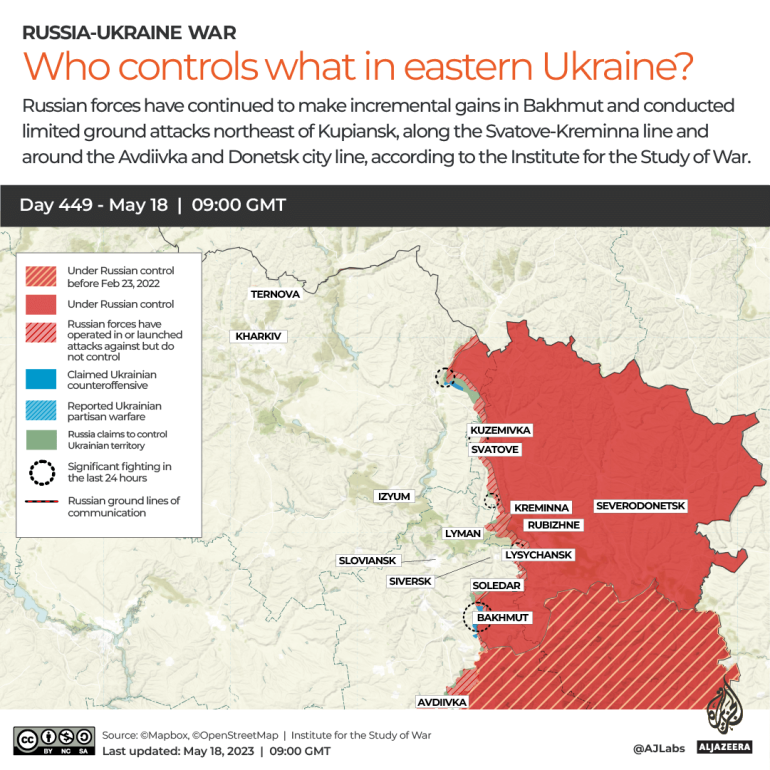
At the same time, Russian sources claimed that Wagner mercenaries had advanced 220 metres (722 feet) within the city.
May 13 followed a similar pattern – Prigozhin claimed his fighters advanced another 500 metres within the city, reducing Ukraine’s foothold from two square kilometres (0.77sq miles) to 1.78sq km (0.69sq miles), but Russian forces lost ground around the city.
Cherevaty said that during May 13-14, Ukrainian units had advanced “from 350 meters [1,148] to two kilometres”. Maliar reported that Ukrainian forces captured more than 10 Russian positions on the northern and southern outskirts of the city on May 14.
Moscow acknowledged that its forces had fallen back to “regroup”, a claim Prigozhin mocked.
“What [Igor] Konashenkov described, unfortunately, is called ‘a rout’ and not a regrouping,” he said, referring to the defence ministry spokesman.
“The enemy has completely freed up the Chasiv Yar-Bakhmut road [T0504] which we had blocked. The enemy is now able to use this road, and secondly, they have taken tactical high round under which Bakhmut is located.”
On May 15, Prigozhin said his forces had advanced another 220 metres in the city, reducing the Ukrainian foothold to 1.59sq kilometres (0.6sq miles).
By May 16, Russia had begun to reinforce its flanks around Bakhmut. A prominent Russian military reporter said four battalions had redeployed there from other parts of the front, something Maliar confirmed, saying Russia had brought in elite Russian Airbourne Forces (VDV).
Counteroffensive delays
The Ukrainian advance around Bakhmut prompted questions about whether Ukraine’s anticipated counteroffensive had begun, which was denied by Ukrainian and Western officials.
Maliar said Ukraine was still conducting defensive operations, which sometimes included counterattacks.
An unnamed senior US official told CNN Ukraine was still conducting “shaping operations” ahead of the counteroffensive, which needed “a bit more time”.
President Volodymyr Zelenskyy offered confirmation when he told the BBC that Ukraine was still waiting for much of the matériel allies had promised. Ukraine would suffer too many casualties if it launched prematurely, he said.
This was almost certainly the motive behind Zelenskyy’s whirlwind tour of European capitals during the week, in which he garnered large new promises of weapons.
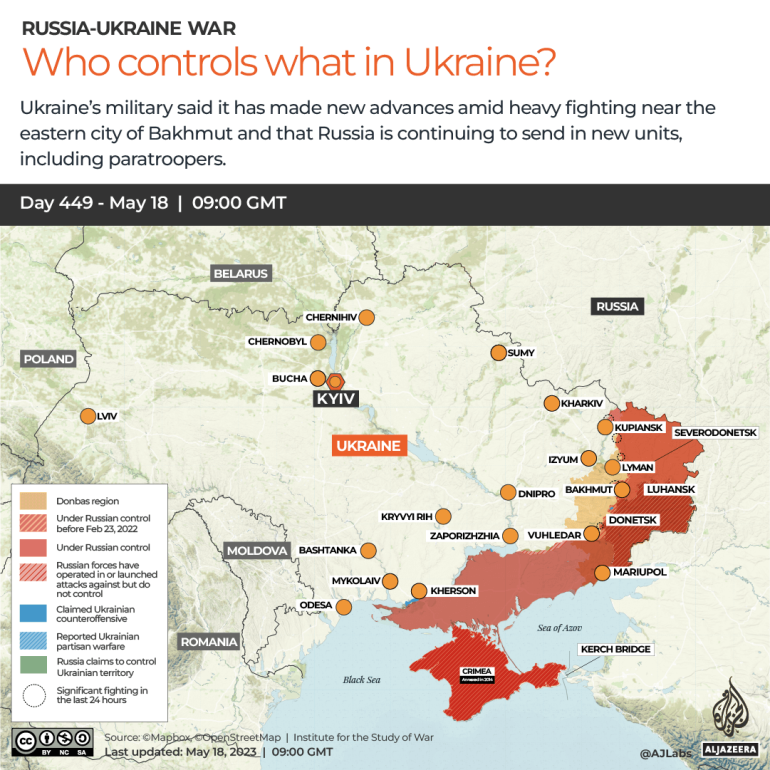
Germany promised its biggest batch of weapons yet on May 14, priced at 2.7 billion euros ($3bn).
Ukraine’s foreign intelligence service said that “the aid package includes in particular: 18 wheeled howitzers, artillery ammunition, guided missiles for air defence systems, four IRIS-T SLM anti-aircraft missile launchers and 12 IRIS-T SLS launchers, 30 Leopard 1A5 tanks and 20 Marder infantry fighting vehicles, more than 100 combat armoured vehicles and more than 200 reconnaissance drones.”
That brought the number of main battle tanks publicly promised to Ukraine to 296. NATO Secretary-General Jens Stoltenberg said on April 17 that 230 of those tanks had already been delivered.
France, one of the first Western allies to promise Ukraine armoured fighting vehicles on January 4, told Zelenskyy that it would provide dozens more.
“In the coming weeks, France will train and equip several battalions with tens of armoured vehicles and light tanks including AMX-10RC,” French President Emmanuel Macron and Zelenskyy said in a joint statement.
The United Kingdom said it would supply Ukraine with hundreds of additional air defence missiles, as well as “long-range attack drones” with a range of more than 200km (124 miles). Days earlier, the UK became the first Western ally to supply Ukraine with long-range cruise missiles, when it said it would supply the Storm Shadow with a range of more than 250km (155 miles).
UK Prime Minister Rishi Sunak also said the UK would start training Ukrainian pilots.
“This summer, we will commence an elementary flying phase for cohorts of Ukrainian pilots to learn basic training. This will adapt the programme used by UK pilots to provide Ukrainians with piloting skills they can apply [to] a different kind of aircraft. This training goes hand in hand with UK efforts to work with other countries on providing F16 jets – Ukraine’s fighter jets of choice.”
Ukraine’s armed forces chief, Valery Zaluzhny, last week said the country was only able to continue defending its air space because it had radically reconfigured the deployment of its existing resources. Ukraine has been asking for F-16 fighter jets, which Western allies have not yet agreed to give.
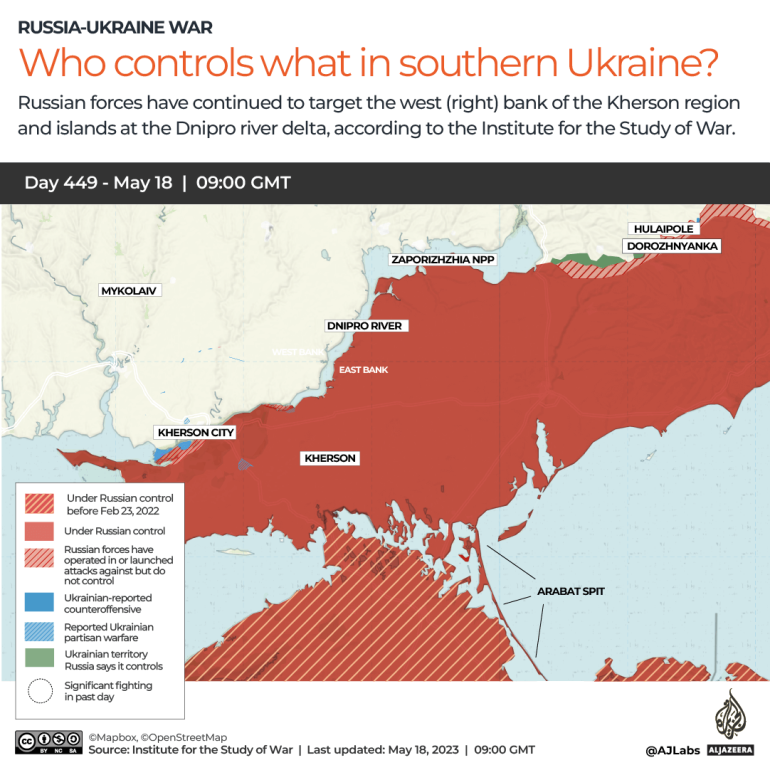
The UK and the Netherlands had agreed to build a coalition to provide Ukraine with F-16 jets, Sunak’s spokesman later said.
“We cannot control the sky,” said Zelenskyy after meeting with Sunak. “We want to create a fighter coalition. We talked about it. I am extremely positive. And, I think, in the near future you will hear about important decisions,” said Zelenskyy.
The UK later said the decision on sending F-16s depends on the White House.
Air defence successes
Despite its air defence shortfalls, Ukraine scored two remarkable successes.
On May 16, Zaluzhny said Kyiv had successfully defeated a Russian missile barrage described by one official as “exceptional in its density – the maximum number of attack missiles in the shortest period of time”.
Zaluzhny said Russia had launched six Kinzhal ballistic missiles, nine Kalibr cruise missiles, and three Iskander land-based cruise missiles. Cruise missiles are notoriously difficult to shoot down because they travel extremely fast on unpredictable trajectories at below-radar altitudes. By 6pm (15:00 GMT), the general staff update reported 27 destroyed cruise missiles.
On May 14, Russian business newspaper Kommersant reported that a Russian Sukhoi-34, Sukhoi-35 and two Mi-8 military helicopters were shot down almost simultaneously in a Ukrainian ambush in the Bryansk region of Russia adjoining Ukraine. Ukraine did not claim the attack.
“According to preliminary data … the fighters were supposed to deliver a missile and bomb attack on targets in the Chernihiv region of Ukraine, and the helicopters were there to back them up – among other things to pick up the ‘Su’ crews if they were shot down,” Kommersant reported.
